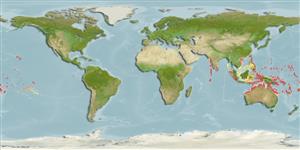>
Anguilliformes (Eels and morays) >
Muraenidae (Moray eels) > Uropterygiinae
Etymology: Uropterygius: Greek, oura = tail + Greek pterygion = little wing. Fin (Ref. 45335).
More on author: Schultz.
Environment: milieu / climate zone / depth range / distribution range
Ökologie
seewasser riff-verbunden; tiefenbereich 5 - 25 m (Ref. 58302), usually 6 - 12 m (Ref. 37816). Tropical; 28°N - 18°S
Indo-Pacific: Maldives to the Pitcairn group, north to the Hawaiian Islands, southwest to Samoa. Also recorded from Ouvéa Atoll, New Caledonia (Ref. 13236).
Size / Gewicht / Alter
Maturity: Lm ? range ? - ? cm
Max length : 30.0 cm TL Männchen/unbestimmt; (Ref. 1602)
Kurzbeschreibung
Morphologie | Morphometrie
Rückenflossenstacheln (insgesamt): 0; Rückenflossenweichstrahlen (insgesamt): 0; Afterflossenstacheln 0; Afterflossenweichstrahlen: 0; Wirbelzahl: 113 - 124. Greatly reduced fins restricted to the end of the tail. Mouth containing numerous needle-like teeth. Uniformly brown anteriorly becoming covered with darker brown spots on the tail.
Inhabits lagoon and seaward reefs (Ref. 30874, 75154), among rubble with algae and invertebrate cover (Ref. 48635, 58302). Benthic (Ref. 58302, 75154). Minimum depth reported taken from Ref. 30874.
Life cycle and mating behavior
Geschlechtsreife | Fortpflanzung | Ablaichen | Eier | Fecundity | Larven
Myers, R.F., 1991. Micronesian reef fishes. Second Ed. Coral Graphics, Barrigada, Guam. 298 p. (Ref. 1602)
IUCN Rote Liste Status (Ref. 130435)
Bedrohung für Menschen
Harmless
Nutzung durch Menschen
Mehr Information
NamenSynonymeMetabolismusRäuberÖkotoxikologieFortpflanzungGeschlechtsreifeAblaichenSpawning aggregationFecundityEierEientwicklung
ReferenzenAquakulturAquakultur ProfilZuchtlinienGenetikElectrophoresesVererbbarkeitKrankheitenVerarbeitungNutrientsMass conversion
PartnerBilderStamps, Coins Misc.LauteCiguateraGeschwindigkeitSchwimmstilKiemenoberflächeOtolithsGehirngrößeSehfähigkeit
Tools
Zusatzinformationen
Download XML
Internet Quellen
Estimates based on models
Preferred temperature (Ref.
123201): 25.4 - 29.4, mean 28.4 °C (based on 1178 cells).
Phylogenetic diversity index (Ref.
82804): PD
50 = 0.5000 [Uniqueness, from 0.5 = low to 2.0 = high].
Bayesian length-weight: a=0.00069 (0.00033 - 0.00144), b=3.12 (2.93 - 3.31), in cm total length, based on LWR estimates for this (Sub)family-body shape (Ref.
93245).
Trophic level (Ref.
69278): 3.4 ±0.5 se; based on size and trophs of closest relatives
Widerstandsfähigkeit (Ref.
120179): mittel, Verdopplung der Population dauert 1,4 - 4,4 Jahre. (Preliminary K or Fecundity.).
Fishing Vulnerability (Ref.
59153): Low vulnerability (20 of 100).
Nutrients (Ref.
124155): Calcium = 61.4 [34.1, 120.5] mg/100g; Iron = 0.572 [0.339, 1.132] mg/100g; Protein = 18.7 [16.4, 21.3] %; Omega3 = 0.122 [0.055, 0.352] g/100g; Selenium = 28.9 [15.7, 60.8] μg/100g; VitaminA = 101 [30, 312] μg/100g; Zinc = 1.19 [0.83, 1.66] mg/100g (wet weight);
